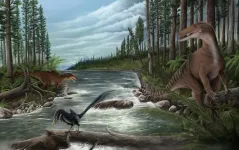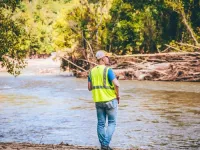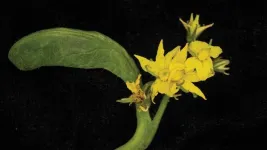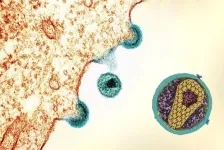(Press-News.org) Groundbreaking research published today in the Journal of Vertebrate Paleontology has unveiled a landmark discovery – fossils of the world’s oldest known megaraptorid and the first evidence of carcharodontosaurs in Australia. These finds rewrite the evolutionary history of theropod dinosaurs, uncovering a predator hierarchy unique to Cretaceous Australia.
The research, led by Museums Victoria Research Institute and Monash University PhD student Jake Kotevski, describes five theropod fossils discovered along Victoria’s coastline. The fossils were unearthed in the upper Strzelecki Group (Bunurong/Boonwurrung Country, Bass Coast, ~121.4-118 million years ago) and the Eumeralla Formation (Eastern Marr Country, Otway Coast, ~113-108 million years ago).
These fossils offer new insights into Victoria’s ancient ecosystem, which was dominated by large powerful megaraptorids (6–7 metres long) alongside smaller carcharodontosaurs (2–4 metres long) and agile, metre-long unenlagiines, or ‘southern raptors’.
‘The discovery of carcharodontosaurs in Australia is groundbreaking,’ says Kotevski. ‘It’s fascinating to see how Victoria’s predator hierarchy diverged from South America, where carcharodontosaurs reached Tyrannosaurus rex-like sizes up to 13 metres, towering over megaraptorids. Here, the roles were reversed, highlighting the uniqueness of Australia’s Cretaceous ecosystem.’
Two of the fossils represent the oldest known megaraptorids globally, expanding our understanding of the group’s evolutionary history and suggesting Australia’s theropod fauna played a pivotal role in Gondwanan ecosystems.
Dr Thomas Rich, senior curator of vertebrate palaeontology at Museums Victoria Research Institute, explains, ‘The findings not only expand Australia’s theropod fossil record but offer compelling evidence of faunal interchange between Australia and South America through Antarctica during the Early Cretaceous. The findings also challenge previous assumptions about body-size hierarchies in Gondwanan predator ecosystems highlighting Victoria’s unique Cretaceous fauna.’
The research demonstrates the vital role of museum collections in building on scientific knowledge and fostering significant scientific breakthroughs. ‘Museum collections are crucial to advancing our understanding of prehistoric life,’ says Tim Ziegler, vertebrate palaeontology collection manager at Museums Victoria Research Institute. ‘Specimens preserved in the State Collection for decades – unidentifiable until now – are providing new insights into the evolution of dinosaur ecosystems.’
Additionally, the research illustrates the multigenerational efforts of Museums Victoria Research Institute palaeontologists. From senior curator Dr Thomas Rich, who has been with the museum since 1974, to collection manager Tim Ziegler and onto the next generation in PhD student Jake Kotevski, this study is one example of the collective efforts of our scientists in creating and sharing trusted knowledge.
Three of the fossils, uncovered between 2022 and 2023, were first identified by Museums Victoria volunteer Melissa Lowery. This discovery highlights the essential contributions of community members working alongside seasoned researchers to further our understanding of Australia's Cretaceous past.
Kotevski and the team continue to survey key fossil sites, including where the fossils of the large megaraptorid were discovered, prompting new avenues of investigation for the Dinosaur Dreaming project, which has led to many significant discoveries including more than 10,000 fossil bones and teeth since the project began – including at least seven different dinosaurs, three groups of mammals, birds, pterosaurs, plesiosaurs, turtles and fishes.
To learn more about Victoria’s ancient ecosystems and fauna, visit Melbourne Museum’s 600 Million Years: Victoria Evolves exhibition and Gandel Gondwana Garden.
This research is a collaboration between Museums Victoria Research Institute and Monash University.
END
New Australian dinosaurs and the oldest megaraptorid fossils in the world
Australia’s first carcharodontosaur fossils unearthed along Victoria’s Cretaceous coast
2025-02-19
ELSE PRESS RELEASES FROM THIS DATE:
EMBARGOED: Study reveals activity of navtemadlin in glioblastoma, points to possible treatment improvements
2025-02-19
Study Title: Window of opportunity trial reveals mechanisms of response and resistance to navtemadlin in patients with recurrent glioblastoma
Publication: Science Translational Medicine
Dana-Farber Cancer Institute authors: Veronica Rendo, PhD, Eudocia Q. Lee, MD, MPH, Veronica Rendo, PhD Patrick Y. Wen, MD, Keith L. Ligon, MD, PhD, Rameen Beroukhim, MD, PhD
Summary: Clinical research by Dana-Farber scientists suggests that combining a novel agent called navtemadlin with DNA-damaging chemotherapy for the treatment of glioblastoma, a form of brain cancer, could increase efficacy. Navtemadlin ...
Kimberly Stegmaier named as Pediatric Oncology Chair at Dana-Farber
2025-02-19
Boston - Kimberly Stegmaier, MD, was named Chair of Pediatric Oncology at Dana-Farber Cancer Institute and Associate Chief of the Division of Hematology/Oncology at Boston Children’s Hospital, in an announcement made today. Her appointment is effective April 1, 2025.
Stegmaier, a Dana-Farber, Boston Children’s Hospital, and Harvard Medical School faculty member since 2002, Stegmaier is currently Vice Chair for Pediatric Oncology Research at Dana-Farber, Co-Director of the Pediatric Hematologic Malignancy Program at Dana-Farber and Boston Children’s Hospital, Co-Leader for the Dana-Farber/Harvard Cancer Center Leukemia Program, and a Professor ...
Human Immunome Project and Michelson Medical Research Foundation award $150,000 grants to three early-career scientists researching immunology and vaccines
2025-02-19
NEW YORK – The Human Immunome Project (HIP) and Michelson Medical Research Foundation (MMRF) have awarded Dr. Omar Abudayyeh (Brigham and Women’s Hospital; Harvard Medical School), Dr. Caleb Lareau (Memorial Sloan Kettering Cancer Center), and Dr. Yuzhong Liu (Scripps Research) the 2024 Michelson Prizes: Next Generation Grants.
The $150,000 research grants are awarded annually to support early-career scientists advancing human immunology, vaccine discovery, and immunotherapy research for major global diseases.
“Investing in bold, early-career scientists fuels the high-risk, high-reward ideas ...
Devastating storms define Appalachia’s 2024 climate
2025-02-19
After a year of weather extremes that brought everything from deadly floods to bitter cold, experts at East Tennessee State University have released a detailed analysis of the region’s 2024 weather patterns.
Their findings highlight both record-breaking temperatures and catastrophic storms – underscoring the growing need for preparedness as communities face unpredictable conditions.
The report, published by Tennessee’s Climate Office housed at ETSU, details how Southern Appalachia endured scorching heat and devastating floods, including the tragic September storm linked to ...
CRISPR manipulates plants’ flower powers
2025-02-19
Humans have appreciated the beauty of flowers for centuries. Yet, flowers aren’t just aesthetically pleasing. They also play a crucial role in plant reproduction. In all plants, a well-studied gene with a curious name, Unusual Floral Organs (UFO), orchestrates the flowering process. UFO expression hinges on another complex process called cis-regulation. And this one has remained a “black box” of plant biology research for years.
Now, using CRISPR gene editing, Cold ...
Text message tool addresses “time toxicity” for cancer patients
2025-02-19
PHILADELPHIA – Cancer patients spend a lot of time on their care. Meeting with doctors and other members of their health care team, getting labs and other tests, picking up prescriptions, and undergoing treatment all takes time. So does getting to and from each appointment, sitting in the waiting room between each appointment, and so on.
In recent years, cancer researchers have worked to quantify the level of “time toxicity” or time spent commuting to, waiting for, and receiving cancer treatment. Now, for the first time, a pilot study has shown it’s possible to use digital technology to safely ...
New therapy may effectively control HIV in Uganda
2025-02-19
A multi-national, multi-institutional study led by Weill Cornell Medicine investigators found little natural resistance to a new HIV therapy called lenacapavir in a population of patients in Uganda.
The study, published Jan. 30 in the Journal of Antimicrobial Chemotherapy, adds to growing evidence that lenacapavir may be a powerful new tool in the global anti-HIV drug arsenal. Approximately, 1.5 million people are living with HIV in Uganda.
“Our data shows that only 1.6% of the individuals studied are living with HIV ...
Global retreat of glaciers has strongly accelerated
2025-02-19
There are currently around 275,000 glaciers worldwide, in which huge quantities of fresh water are stored. But this reservoir is increasingly shrinking. Since the turn of the millennium, glaciers around the world – i.e. ice masses on land excluding the Greenland and Antarctic ice sheets – have lost around 273 billion tonnes of ice per year. This corresponds to about five and a half times the volume of Lake Constance. Overall, the world’s glaciers have lost around five per cent of their total volume since the year 2000. This is the conclusion reached by an international research team of which Tobias Bolch from the Institute of Geodesy ...
Data from all 50 states shows early onset breast cancer is on the rise in younger women: Does place of exposure matter?
2025-02-19
February 19, 2025-- Breast cancer incidence trends in U.S. women under 40 vary by geography and supports incorporating location information with established risk factors into risk prediction, improving the ability to identify groups of younger women at higher risk for early-onset breast cancer, according to a new study at Columbia University Mailman School of Public Health. This study comprehensively examined trends across different states, regions, metropolitan versus non-metropolitan areas and by racial and ethnic groups. It also is one of the first to incorporate ...
California prison resentencing project yields modest results
2025-02-19
A three-year effort to encourage California prosecutors to reconsider the sentences given to some people in state prison has resulted in a modest number of people being resentenced, but improvements are needed to speed review of more cases, according to a new RAND report.
During the project involving nine counties, more than 1,100 cases received an initial review. After comprehensive reviews by county district attorneys for the suitability for resentencing, 227 individuals eventually received new sentences and 174 of those offenders had been released ...
LAST 30 PRESS RELEASES:
University of Oklahoma researcher awarded funding to pursue AI-powered material design
Exploring how the visual system recovers following injury
Support for parents with infants at pediatric check-ups leads to better reading and math skills in elementary school
Kids’ behavioral health is a growing share of family health costs
Day & night: Cancer disrupts the brain’s natural rhythm
COVID-19 vaccination significantly reduces risk to pregnant women and baby
The role of vaccination in maternal and perinatal outcomes associated with COVID-19 in pregnancy
Mayo Clinic smartwatch system helps parents shorten and defuse children's severe tantrums early
Behavioral health spending spikes to 40% of all children’s health expenditures, nearly doubling in a decade
Digital cognitive behavioral treatment for generalized anxiety disorder
Expenditures for pediatric behavioral health care over time and estimated family financial burden
Air conditioning in nursing homes and mortality during extreme heat
The Alps to lose a record number of glaciers in the next decade
What makes a good proton conductor?
New science reporting guide published for journalists in Bulgaria
New international study reveals major survival gaps among children with cancer
New science reporting guide published for journalists in Turkey
Scientists develop a smarter mRNA therapy that knows which cells to target
Neuroanatomy-informed brain–machine hybrid intelligence for robust acoustic target detection
Eight SwRI hydrogen projects funded by ENERGYWERX
The Lundquist Institute and its start-up company Vitalex Biosciences Announces Strategic Advancement of Second-Generation fungal Vaccine VXV-01 through Phase 1 Trials under $40 Million Competitive Con
Fine particles in pollution are associated with early signs of autoimmune disease
Review article | Towards a Global Ground-Based Earth Observatory (GGBEO): Leveraging existing systems and networks
Penn and UMich create world’s smallest programmable, autonomous robots
Cleveland researchers launch first major study to address ‘hidden performance killer’ in athletes
To connect across politics, try saying what you oppose
Modulating key interaction prevents virus from entering cells
Project explores barriers to NHS career progression facing international medical graduates
Jeonbuk National University researchers explore the impact of different seasonings on the flavor perception of Doenjang soup
Two Keck Medicine of USC Hospitals named Leapfrog Top Teaching Hospitals
[Press-News.org] New Australian dinosaurs and the oldest megaraptorid fossils in the worldAustralia’s first carcharodontosaur fossils unearthed along Victoria’s Cretaceous coast





